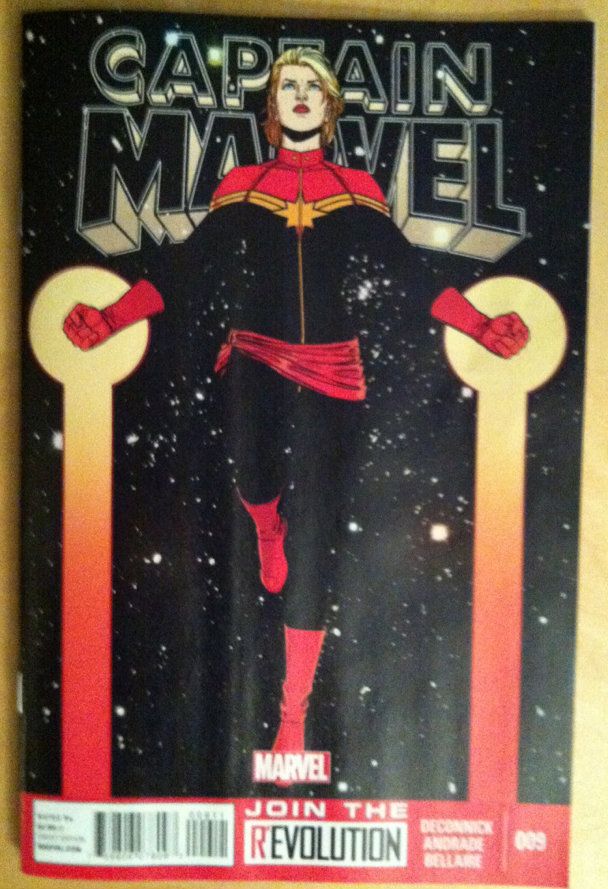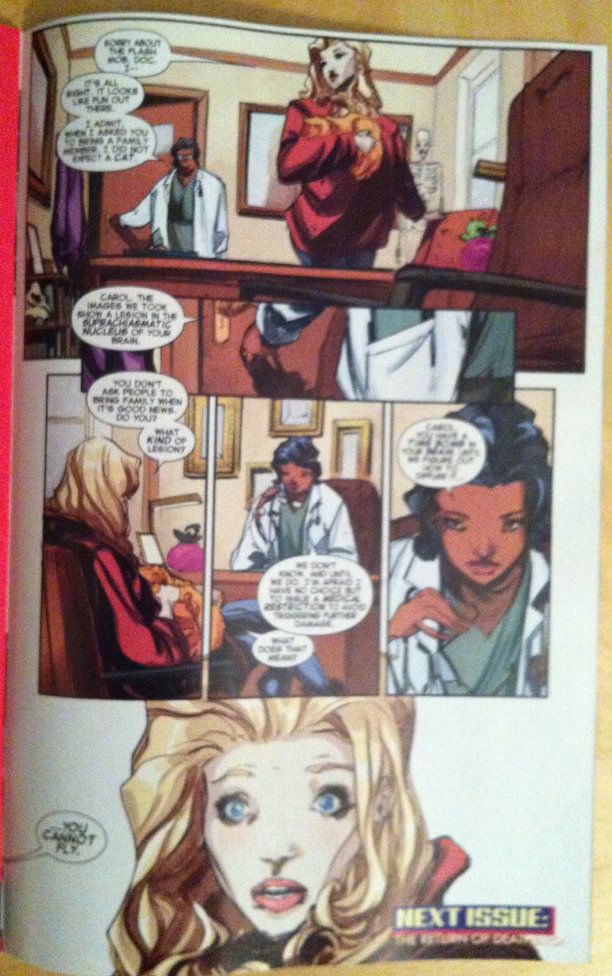Or an excuse to talk about Science in the context of comic books.
There be *SPOILERS* in this one. So go read Captain Marvel #9 before reading this post. Don't have it? Shame on you, this is an amazing comic.
First let it be said that Captain Marvel #9 kicks so much ass. I mean, I've really enjoyed every issue of Captain Marvel so far, but this one is fantastic. To the point where if someone were to ask me "Why do you read superhero comics?", I could answer "Because Captain Marvel #9". It's based around a slice-of-life ordinary day for Carol and is filled with satisfying character moments, little snippets of great comedy, a broadening supporting cast, and a gun point standoff. And a ridiculous "lucky" touque (I'm Canadian, we have a word for that). AND dinosaurs in downtown Manhattan. In Captain Marvel #9 Kelly Sue DeConnick manages to turn what could kind of be considered a setup/logistical issue into a beat perfect superhero comic. Filipe Andrade, this issue's artist, has a kinetic and kind of exaggerated style that is pretty great and completes the package. Did I mention I really like this comic?
Anyway, on the last page *SERIOUS SPOILERS* it's revealed that Carol has a lesion in the Suprachiasmatic Nucleus of her brain.
You might be wondering, what is a Suprachiasmatic Nucleus (or SCN). Well, since two of my favourite non-human things are Science and comics, I'll try to defuse this jargon.
Structurally the SCN is a small collection of neuron cells that live kind of behind the optic nerve and some visual signalling structures (one of which is called the optic chiasm) in the brain. In the brain, small clusters of neurons are referred to as a nucleus (not to be confused with the nucleus that contains DNA; Scientists are the worst at naming things). So we have a collection of neurons that lives close to the optical chiasm: hence Suprachiasmatic Nucleus.
But brain structures only matter in so far as they do something. So what does the SCN do? Well, it's where our bodies' internal clock lives.
People evolved on a planet that has light and dark cycles; day and night. A consequence of this is that our bodies adapted to do certain things at certain times of the day. Like to sleep at night and wake up in the morning or to get hungry during the day, but to fast and slow our metabolism at night. To manage this our brains contain a time keeping mechanism that counts out almost exactly 24 hours before resetting. And this time keeping mechanism lives in the SCN. Which is pretty cool. But how does it work?
So a clock works because some part of it is able perform a motion in a consistent, regular way. A grandfather clock has a pendulum (a big ass weighted chain) that sways back and forth at a regular interval (which is maintained by a slowly uncoiling spring). Old pocket watches work by winding a spring that slowly and regularly uncoils and spins gears that turn with a certain speed to keep time. Modern watches use a piezoelectric crystal (essentially a cool rock that will physically oscillate in size (a little) when you run an electric field through it from, say, a watch battery) to mark the regular, periodic passage of time. Well, the SCN works in a fairly similar way, except it oscillates protein levels to tell time.
In the SCN a protein called CLOCK ("circadian locomotor output cycles kaput"... because sometimes Scientists DO name things well) is produced. CLOCK is something called a "transcription factor", which is a protein that can bind to DNA in a cell and turn on or off the production of other proteins. They are kind of like control switches. Anyway, in the SCN, CLOCK is made at a steady rate. Initially it has a low concentration and is stuck in the main compartment of the cell (called the Cytoplasm). Eventually CLOCK reaches a high enough concentration to enter the Nucleus of the cell and bind to DNA. CLOCK can turn on and off a lot of different protein making pathways, but some key genes that get turned on are the ones that manufacture Period (PER) and Cryptochrome (CYC) proteins. PER and CYC are also transcription factors, and when they are turned on they bind to DNA and turn off the production of CLOCK. This causes CLOCK levels to fall (because cells recycle things), which eventually means CLOCK can't turn on PER and CYC, which means PER and CYC can't turn off CLOCK, which means that CLOCK production starts up again. The cycle repeats.
So to recap, in the SCN during a 24 hour day, CLOCK is made until it turns on production of PER and CYC which turns off CLOCK which eventually will turn off PER and CYC which turns on CLOCK. And then this repeats during the next 24 hours. Which is, in a basic sense, how your brain keeps track of time.
Of course, it's WAY more complicated than that. There are other proteins in the SCN that also fluctuate during a 24 hour period and interact with CLOCK to help keep time. (such as BMAL1, REV-ERBa, RORa etc). Your brain also takes in environmental information and uses this to fine tune the clock. So things like light and dark are used to alter the clock and make it run even more accurately. (Which is why it is important to sleep in a DARK room and why when my dog needs a 3am emergency bathroom run involving a well lit hallway my sleep gets ruined.) But all of this action takes place in the SCN.
Information from the clock in the SCN gives timed instructions to other areas of the brain, like centres that control wakefulness and hunger or regulate the release of hormones like insulin, melatonin, and growth hormone. So it's a pretty important little structure that affects pretty much every other system in your body.
Which makes the SCN not a great place to have a lesion.
Did I mention I love this comic book?




I wasn't completely convinced on Captain Marvel (the time travel thread earlier was fairly confusing) until this issue. Really enjoyed it! Thanks for the sciencey explanations!
ReplyDelete